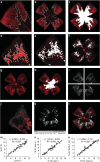The mouse retina as an angiogenesis model
- PMID: 20484600
- PMCID: PMC2891451
- DOI: 10.1167/iovs.10-5176
The mouse retina as an angiogenesis model
Abstract
The mouse retina has been used extensively over the past decades to study both physiologic and pathologic angiogenesis. Over time, various mouse retina models have evolved into well-characterized and robust tools for in vivo angiogenesis research. This article is a review of the angiogenic development of the mouse retina and a discussion of some of the most widely used vascular disease models. From the multitude of studies performed in the mouse retina, a selection of representative works is discussed in more detail regarding their role in advancing the understanding of both the ocular and general mechanisms of angiogenesis.
Figures






References
-
- Kennedy D. Breakthrough of the year. Science 2006;314:1841. - PubMed
-
- Kempen JH, O'Colmain BJ, Leske MC, et al. The prevalence of diabetic retinopathy among adults in the United States. Arch Ophthalmol 2004;122:552–563 - PubMed
-
- Klein BE. Overview of epidemiologic studies of diabetic retinopathy. Ophthalmic Epidemiol 2007;14:179–183 - PubMed
-
- Congdon N, O'Colmain B, Klaver CC, et al. Causes and prevalence of visual impairment among adults in the United States. Arch Ophthalmol 2004;122:477–485 - PubMed
-
- Friedman DS, O'Colmain BJ, Munoz B, et al. Prevalence of age-related macular degeneration in the United States. Arch Ophthalmol 2004;122:564–572 - PubMed
Publication types
MeSH terms
Grants and funding
LinkOut - more resources
Full Text Sources
Other Literature Sources
Miscellaneous

